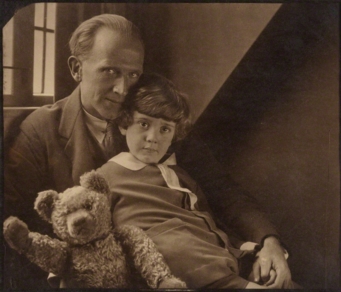Alan Alexander “A.A.” Milne was born in London on January 18, 1882. A novelist, poet, playwright and essayist, Milne was a prolific writer for over thirty years. His career can be roughly divided into three parts: the first as a humorist for the British humour magazine, Punch, the second as a playwright, and the third as a children’s author.
The years Milne spent studying at Westminister School and Trinity College, Cambridge were incredibly formative years for his career as a writer and as an individual. Initially, he lived the life of a scholar, having attended Cambridge due to its educational reputation and emphasis on mathematics. (In fact, he graduated with a B.A in Mathematics.) However, Milne began to develop a passion for reading by nurturing his aptitude for words through literary studies and his involvement with a student magazine. He edited and wrote for the Cambridge undergraduate magazine, Granta, and later Punch; both experiences undoubtedly motivated his foray into writing as a career. While Milne established a reputation as a playwright and an essayist, having published numerous works ranging from satirical magazine essays to comedic plays such as Belinda and The Truth about Blayds, his most enduring work to this day has been his children’s books set in the fictional Hundred Acre Wood: Winnie-the-Pooh.

A famous and iconic photograph by Howard Coster of A.A. Milne, his son Christopher Robin and Pooh Bear at Cotchford Farm, their home in Sussex, dated 1926 and in the collection of the National Portrait Galley, London, a gift of the estate of Howard Carter 1959.
In 1913, Milne married Dorothy “Daphne” de Sélincourt and they had one son named Christopher Robin (1920). The birth of his only son Christopher Robin affected Milne’s writing career, as he began to take an interest in writing books for children. In fact, his son and his stuffed animals in the household became the source inspiration for the character of Christopher Robin and his collection of animal friends in Milne’s Winnie-the-Pooh books. Milne explains in his Autobiography that the character of Christopher Robin is also as much himself as it is his son between the ages of three and six. While Milne may have been thinking about his own childhood and portraying that in his books, there are signs that he was also reflecting on the people the surrounded him in his life as he was writing Winnie-the-Pooh.
The first book, When We Were Very Young (1924) was considered to be a success by Milne’s publisher at the time. When We Were Very Young consisted of a series of poems written about Christopher Robin. Due the popularity of Winnie-the-Pooh, Milne subsequently published a sequel titled Winnie-the-Pooh (1926), another book of poetry, Now We Are Six (1927), and lastly a book that introduced Tigger, The House at Pooh Corner (1928). Milne created a total of four books in the Pooh universe between 1923 and 1928, all of which are still in print. Yet, his success was met with some criticism. Critics rejected his children’s books for what they perceived to be smugness, the acceptance of sexist and imperialist values, and a lack of social responsibility. Nonetheless, there is no denying the popularity and success of Milne’s writing, as his books have spanned across eight decades worth of readers.
It is important to note how Milne’s children’s books engage with language in a intelligent way that demonstrates his intrigue with sounds, rhythms, and uses of words. For Milne, language behaved as a tool for entertainment, not used to instruct or philosophize. His language contains hidden messages through the use of special punctuation and satirical capitalization or lack of capitalization (Lurie 15). Such a whimsical attitude towards language allows Milne to engage both the younger emerging reader and the adult reader with his work in a way that was perhaps not conventional at the time for other children’s authors. His books provide a temporality that is key to the construction of a childhood that is assumed and defined in terms of both the child within the text and the implied reader of the text.
Milne’s Winnie-the-Pooh books are universally loved to this day because of the crafted wordplay, engaging prose style, light verse and sentimentality that simultaneously typifies memorable characters and makes fun of them.